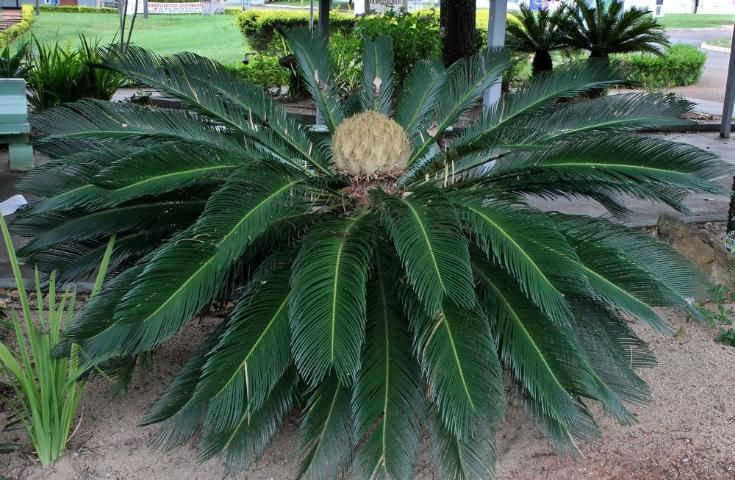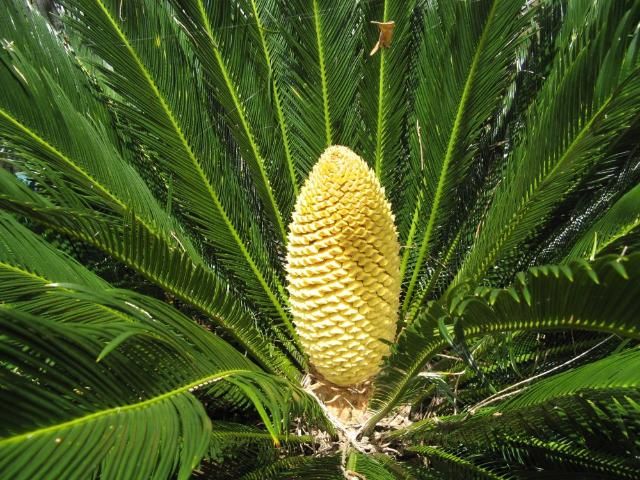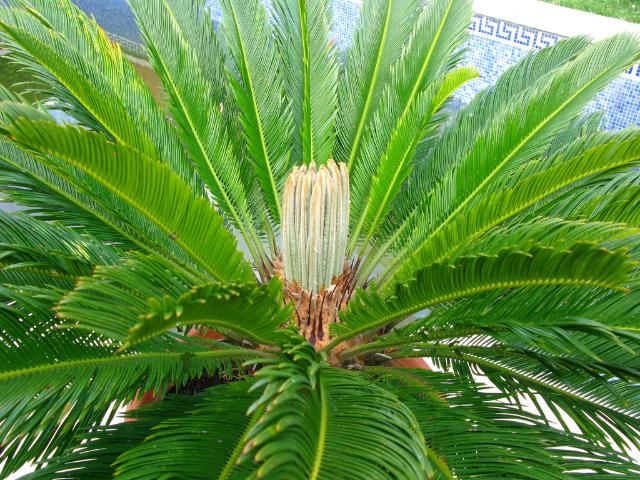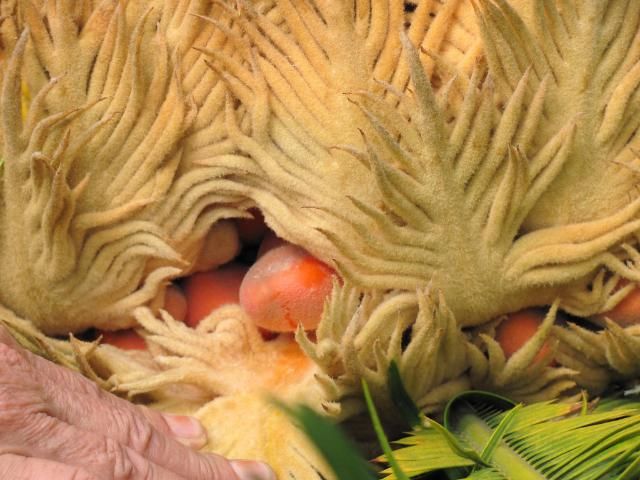Family
Cycadaceae, cycad family.
Genus
Cycas stems from the Greek name cyca, which means "palm." Cycas are gymnosperms and, though palm-like, they are unrelated to true palms, which are actually angiosperms (flowering plants).
Species
The species name revoluta stems from the Latin word revolut, which means "rolled back." The name refers to the leaflets of the sago palm, which curl under.
Common Names
Sago Palm, King Sago Palm, Japanese Sago Palm
Many common names for this and other cycads include the word "palm" because these plants have a superficial resemblance to palm trees. The term "sago" refers to a type of edible starch that can be extracted from these plants. Sago is used as a food source in Asia, particularly in New Guinea. Most sago is commercially extracted from a type of palm, Metroxylon sagu, which is sometimes called "true sago palm" to distinguish it from this cycad species.
Description
This evergreen cycad is native to the tropical islands of southern Japan, but it grows well in the subtropics of the United States, particularly in Florida, California, Georgia, and Puerto Rico. Sago palm grows well in full sun or partial shade but exhibits larger leaves in more shaded situations. Slow growing, the sago palm can reach heights of up to 15 feet in 50 years. Leaves are pinnately compound, 4 to 5 feet long, and up to 9 inches wide. The dark-green, stiff leaflets have a linear shape with a shiny upper surface. They are approximately 4 inches long, have revolute or curled under margins, and an acuminate or pointed tip. The trunk of the sago palm is dark brown and thick, and appears shaggy. Plants are either male or female and the reproductive structures are found in the center of the plant. The male organ resembles a large yellow cone that reaches lengths of up to 2 feet. The female organ resembles a yellow furry globe, and it houses many bright orange seeds that are 2 inches in diameter.

Credit: Mauricio Mercadante, CC BY-NC-SA 2.0

Credit: cskk, CC BY-NC-ND 2.0

Credit: Rafael Valls, CC BY-NC 2.0

Credit: r0sita, CC BY-SA 2.0
Allergen
Male plants are considered moderately allergenic, but female plants cause little to no allergies.
Applications
Commercial/Practical
Historically, the inner bark of the sago palm was used as a food source in Japan during times of famine. However, sago palm contains a powerful neurotoxin that can cause paralysis or even death if it is not prepared properly. The seeds can also be poisonous to humans and animals if ingested. Today, the dried leaves of this plant are commonly used as accents in floral arrangements.
Horticultural
This cycad can thrive both indoors and outdoors. Once it becomes established outdoors, sago palm is considered to be drought resistant but not freeze tolerant. In the Florida yard, it is a great accompaniment to other palms and thick grasses. Sago palm also makes a great walkway border, but it should be placed where bare skin will not contact or brush against the sharp, pointed tips of its leaflets. Depending on the available planting space, an important growth trait to consider is that male plants tend to branch out more than do female plants. More importantly, take caution when using this plant as an accent in home landscapes, since it contains a strong neurotoxin that can paralyze or even kill animals or humans who ingest it. In Japan, a bonsai variety of sago palm (Cycas nana) is created by packing sand around the plant's roots and rationing the amount of water it receives. This stunts the palm's growth, giving it a bonsai-like appearance. In Florida, one of the greatest damaging agents to this species is the cycad aulacaspis scale (Aulacaspis yasumatsui). Information on how to manage this insect can be found at the following website: https://edis.ifas.ufl.edu/publication/IN253.
References
Borror, D. J. 1988. Dictionary of root words and combining forms (1st ed.). Mountain View, CA: Mayfield Publishing Company.
Coombes, A. 1994. Dictionary of plant names: Botanical names and their common name equivalents. Portland, OR: Timber Press.
Dehgan, B. 1998. Landscape plants for subtropical climates. Gainesville, FL: University Press of Florida.
Floridata.com. 2009. Cycas revoluta, Retrieved from http://www.floridata.com/ref/C/cyca_rev.cfm .
MacCubbin, T. 2005. Month-by-month gardening in Florida: What to do each month to have a beautiful garden all year (Revised ed.). Franklin, TN: Cool Springs Press.
Ogren, T. L. 2000. Allergy-free gardening: The revolutionary guide to healthy landscaping. Berkeley, CA: Ten Speed Press.
USDA Natural Resources Conservation Service. (n.d.). PLANTS database. Retrieved from http://plants.usda.gov/index.html